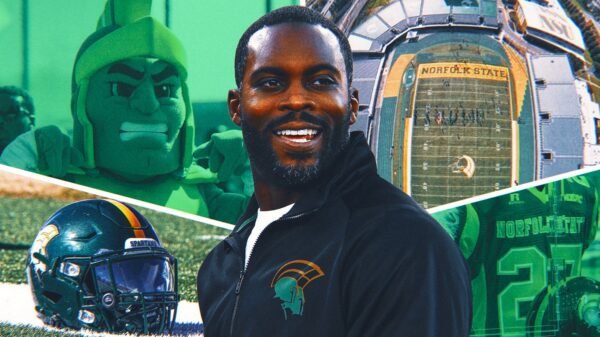Is it time to panic about Michigan, USC, and Oklahoma? The short answer is yes, especially for these storied programs that have struggled in the current college football season.
As the season approaches its midway point, attention shifts to these once-powerhouse teams, which have found themselves faltering in the inaugural year of the superconferences. Michigan, USC, and Oklahoma each faced setbacks in Week 8, with Michigan and Oklahoma both falling to 4-3 records, while USC’s loss to Maryland left them at 3-4.
Given the current trajectory, it’s evident that none of these teams will qualify for the College Football Playoff this season. However, they still have opportunities to build for 2024. The pressing question is whether these programs should be in a state of alarm regarding their performance and future direction. Let’s analyze each team closely.
Michigan: Alarm Bells Ringing
For Michigan, the current situation is cause for concern, not just for the present but potentially for the future.
The Wolverines are struggling significantly at quarterback and in their passing game, ranking 129th in passing offense with an average of just 128 yards per game heading into Week 9. Such statistics are unacceptable. Additionally, Michigan has seen an increase in turnovers while its third-down conversion rate has dropped compared to last year.
The predictability of Michigan’s offense is alarming, as they frequently rely on a run-first approach before attempting a pass to standout tight end Colston Loveland. This strategy has led to frequent punting, especially since Loveland often faces double coverage, limiting the effectiveness of the passing game. While Michigan’s running game shows promise and physicality, the lack of a viable passing attack is detrimental to their success.
In the offseason, Michigan misjudged its quarterback and wide receiver talent. The Wolverines might now regret their decisions, but they cannot reverse the clock. In today’s landscape, the transfer portal offers teams a chance to address positional weaknesses. Texas, for instance, successfully bolstered its roster by adding talent at wide receiver and safety.
It’s conceivable that Michigan didn’t have sufficient time to utilize the transfer portal effectively, especially considering Jim Harbaugh’s departure. Regardless, the evaluation of key positions was poorly executed. When teams fail to assess their needs accurately, the results are often disappointing.
Targeting transfer wide receivers may prove challenging for Michigan due to their current offensive style. However, praise is due for J.J. McCarthy, who previously excelled as a quarterback. Many believed that the offensive philosophy was the key to Michigan’s success, particularly given their strong ground game. McCarthy was particularly effective on third downs last season, allowing the team to maintain its approach. The departures of Roman Wilson and Cornelius Johnson have further complicated matters, especially since their contributions were underestimated.
With those key players gone, Michigan’s inability to accurately assess the quarterback situation and the wide receiver depth has become evident. The Wolverines are attempting to replicate last year’s successful strategy, but they are no longer the same team that dominated opponents. Their style of play comes with a narrow margin for error.
Looking ahead, Michigan’s schedule appears daunting. Upcoming games against Michigan State, Oregon, Indiana, Northwestern, and Ohio State could further complicate their chances of securing a bowl game this season.

Sherrone Moore led the Wolverines to four victories as interim coach in 2023 but has since faced challenges this season, posting a 4-3 record. (Photo by Michael Hickey/Getty Images)
Regardless of Michigan’s outcomes, fans may need to cling to memories of their national title year. The recent turnaround of the program provides a glimmer of hope for potential future improvements.
USC: Frustration Without Panic
For USC fans, the situation is exasperating. The team has faced a narrow margin of error this season, leading by at least seven points in the fourth quarter of all four losses. The Trojans’ four blown leads in the final quarter are tied for the highest in the nation, indicating they have been in competitive positions, only to falter.
The frustration is compounded by the fact that this is not Lincoln Riley’s inaugural season. Unlike Sherrone Moore, who faced a challenging offseason at Michigan, Riley must confront the reality of Year 3 without the same level of progress. Fans are left wondering, “Why are these issues persisting?”
A common adage in college football states that rebuilding programs often experience significant losses before they start to lose narrowly, then progress to small victories, and eventually achieve bigger wins. This progression is not instantaneous, and the turnaround witnessed at Indiana is more of an exception than a rule.
To understand USC’s current situation, one must consider whether this is Year 3 under Riley or essentially a reboot without Caleb Williams, alongside new defensive coordinator D’Anton Lynn. This could be a transitional phase for the program.
Some may view this perspective as overly lenient, but it’s essential to assess USC’s circumstances honestly. The offense is quite young, featuring a first-year starter at quarterback. This youth may be keeping them at the losing-small stage while they strive to reach winning-small.
If USC can convert one of these narrow losses into a victory, it could shift the team’s momentum. They have been competitive in every game, with their four losses amounting to just 14 points combined.
This may represent the low point of Riley’s time at USC. The course of the program can change dramatically with just one victory. While it remains uncertain if this will happen, the transition from losing small to winning small can occur swiftly.
In assessing whether coaching, players, or scheme are at fault, Riley likely feels some confidence in all three areas. The scheme and players have positioned the Trojans to win, and Riley has made improvements to his coaching staff over the offseason.
Riley’s primary task this season is to find wins to build upon. The Trojans should be competitive in their remaining five games against Rutgers, Washington, Nebraska, UCLA, and Notre Dame. Retaining players will be crucial in the offseason, as they have the potential to return nine starters on offense, although this will be challenging in the current era. Miller Moss also has an additional year of eligibility, adding to the team’s depth.

After finishing 10-4 in 2022, Lincoln Riley’s record at USC has dropped to 11-9 over the past two seasons. (Photo by Greg Fiume/Getty Images)
The outlook for USC appears to be improving, and a turnaround may be on the horizon.
Oklahoma: Alarm Bells and Worries
Oklahoma fans are understandably anxious. Brent Venables, now in his third year, has witnessed his team suffer significant defeats against Texas and South Carolina, scoring only one touchdown in those two games. The Sooners’ debut season in the SEC has not gone according to plan.
The challenging schedule was anticipated, and discussions around it were prevalent before the season began. However, the offense has been a disappointment. Concerns have persisted since the Tennessee game, with the quarterback situation failing to yield positive results regardless of who was under center. The problems persisted even when Michael Hawkins Jr. took over for Jackson Arnold, indicating a deeper issue with the offensive scheme.
Recent developments have confirmed these concerns, as Oklahoma fired offensive coordinator Seth Litrell earlier this week, reinstating Arnold as the starting quarterback. Currently, the Sooners rank 107th in scoring and 116th in total yards, signaling a major breakdown in offensive productivity.
It’s important to note that injuries have severely impacted the wide receiver corps, with players like Andrel Anthony, Jalil Farooq, Nic Anderson, and Jayden Gibson missing significant time. While injuries provide some context for the struggles, the film reveals that the entire offensive system is flawed. The offensive line has not performed well, and attempts to establish the run game have been futile.
In evaluating the issues, it becomes clear that the coaching and scheme are the primary culprits. While the injuries do play a role, the coaching staff and system require significant changes. Venables has taken steps to address the coaching aspect, which is commendable.
However, Oklahoma’s offense is currently in a state of limbo, as Joe Jon Finley is not expected to remain as offensive coordinator beyond this season. Like Michigan, the Sooners may face more challenges before improvements are seen.
Looking ahead, Oklahoma’s schedule poses further challenges with upcoming games against Ole Miss, Missouri, Alabama, and LSU. The question remains: how will Oklahoma address its offensive struggles? The current game plan appears to rely on sheer effort, but the placeholder offense may not be sustainable.

After a 10-3 season last year, Brent Venables’ Oklahoma team currently stands at 4-3 in 2024. (Photo by Aaron M. Sprecher/Getty Images)
As Venables navigates the remainder of the season, retaining talented offensive players will be essential. He also faces a pivotal moment in hiring a new offensive coordinator, a decision that could reshape the program’s future. Similar to the challenges faced by Riley at USC and Harbaugh at Michigan, the right hire could have a transformative impact on Oklahoma’s trajectory.
Venables should consider unconventional candidates for the offensive coordinator position, similar to Bob Stoops when he hired Riley in 2015. An innovative hire, possibly from the NFL or an unexpected source, could lead to significant improvements. Recent examples in college football demonstrate the potential benefits of such strategic moves.
The challenge for Venables lies in balancing fan expectations with the need for a bold hire. With job security potentially at stake, the decision-making process will be critical. Candidates like UNLV offensive coordinator Brennan Marion and Indiana offensive coordinator Mike Shanahan represent the type of innovative thinking that could benefit Oklahoma.












































